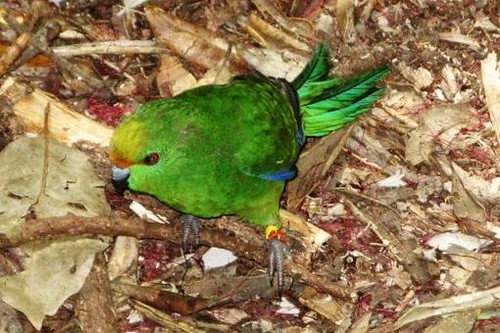 Orange-fronted parakeets/kākāriki (Cyanoramphus malherbi)Birds thrive as rat population dives in the Hawdon Valley
Orange-fronted parakeets/kākāriki (Cyanoramphus malherbi)Birds thrive as rat population dives in the Hawdon Valley
Rat numbers are down, and native birds are thriving following a 1080 drop in the Hawdon Valley, latest monitoring results show.
Prior to the 1080 application in mid September the rat population in the Hawdon Valley, Arthur’s Pass National Park, had reached critical levels due to a local beech mast – indicating an imminent rat plague just as the orange-fronted parakeet (käkäriki) begin nesting.
The orange-fronted parakeets are only found on the mainland in three beech-clad valleys in Canterbury. Rats attack the eggs, chicks and parents as they nest in tree hollows.
According to biodiversity programme manager Mike Ambrose, no intervention would almost certainly result in local extinction of these critically endangered birds.
“Timing is crucial in effectively controlling these rodents, and aerial 1080 is the only viable option for this 3500ha area,” says Mr Ambrose.
Rat population data is gathered via 200 tracking tunnels throughout the controlled area. The percentage of tunnels that show evidence of rats walking through them over a set period is used to gauge the population density.
Anything above 5% of tunnels with tracking evidence indicates a potentially serious threat to the birds necessitating intervention to avoid large-scale predation. In August rat tracking was 22.7% in the Hawdon treated area and in October after the 1080 application, this had been reduced to 1.5%. The adjacent non-treated area used as a control showed 34% tracking in August, with in increase to 38% in October.
To address public concerns that 1080 could also kill the very birds being protected, selected species are monitored before and after the operation.
“The latest results show that 13 kea and 23 kiwi fitted with radio transmitters are all alive and well,” said Mr Ambrose.
Orange-fronted parakeets are not tagged, but are monitored by staff over the breeding season.
“Last year we monitored 13 breeding pairs, all of which successfully raised at least one clutch of eggs, with some re-nesting 2 or 3 times. The staff are back in the field again for this season and early reports indicate a healthy population of orange-fronted parakeets”.
Mr Ambrose believes that the good outcome from the 1080 operation will result in another successful year for the orange-fronted parakeet, mohua, great-spotted kiwi and kea. These native birds are threatened by rats, stoats or possums which are being successfully controlled through a range of different methods including trapping and poisoning.